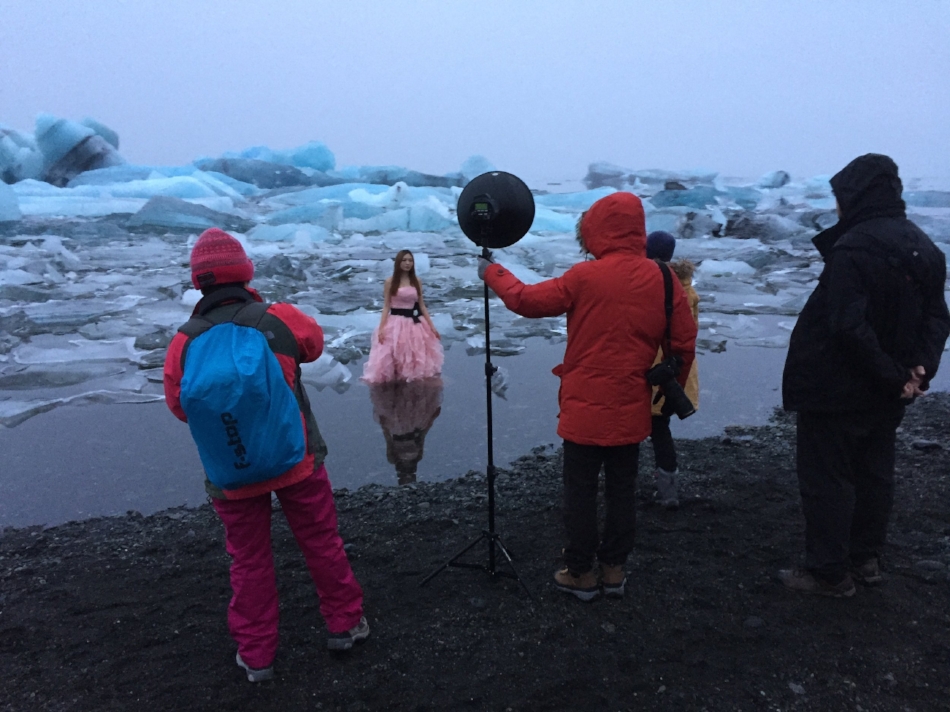Iceland has no shortage of surprises for guests on its glacial shores. Imagine you’ve been driving around route 1 with a portable hotel for days. You’ve been dazed by natural beauty and drama, and whipped by the same fresh winds that half-giants called home.
And yet, as you near back to where you started, there is plenty to stun and inspire.
Taking a step outside the hotel-mobile
The Jökulsárlón is an eery beautiful sight. Jökulsárlón litterally means “the glacier’s lagoon”, and it very much is. South of the lagoon, the sea, and North of it, the massive Vatnajökull glacier. Vatnajökull translates as “the glacier’s waters”, so you can see, Iceland is good with names. And “the glacier’s lagoon” is like no other.
Stillness, and a beach of black sand, surround the blue Ice
The Vatnajökull glacier, ‘feeding’ water and ice to the lagoon’, is so huge that it covers almost a tenth of the entire island, and tops the ‘Europe’s hugest ice caps’ list by virtue of ‘most ice’. And while the ice is high up, far away from the tourist’s gaze, magic happens - then, it breaks, crashes or floats down, to appear a wonderful blue in the lagoon. Or black, if it is carrying volcano ash.
In the midst of a grey trip, the colours of Jökulsárlón stand out
The quiet and cold around the lagoon are a great moveless spectacle. Birds fly here and there, and seals elegantly paddle by, but the stillness of the place makes one feel… silent. Any sound quickly dies, to leave its place with haste, to a cool, heavy, frozen silence. An absorbing, overpowering silence. A silence so deft, she could muffle her visitor in her palm, and slowly, unnoticed, take, and keep him.
The beauty of the lagoon is not lost on too many, and funnily enough, all sorts have come here to make the most of this frozen sight. Movies (2 James Bond-ses!), music clips, adventurers with bad quality camcorders (see above)... Add to that, during the afternoon these ukes were there, a crew of heavily coat-ed guys from (probably) Japan, making a young pretty model do something silly, for the benefit of (probably) a new fragrance or a magazine’s signature hair colour.
freeze frame technique
BEN’s BIT OF SCIENCE
WHY IS THE ICE BLUE ?
Basically, on the Vatnajökull, there is a whole lot of ice.
All this ice creates massive pressure, or weight.
On occasion, when it snows, air bubbles are compressed out of the snow as it becomes part of the glacier. The ice created is then heavier, or denser.
In this process, the ice crystals enlarge, meaning that the ice becomes better at absorbing colours. But not blue so much (an oxygen-hydrogen thing). So if it absorbs other colours than blue, it refracts, or sends back, more blue. So blue light bounces off of it and reaches our eyes. So it looks blue. So… it’s blue !!
Photograph of the Vatnajökull and lagoon, circa 1947, colourised (joke)
HAS IT ALWAYS BEEN LIKE THIS? (UHM… NO, AND IT MIGHT NOT BE FOR LONG EITHER)
The Glacier’s lagoon wasn’t there a hundred years ago. Instead there was what can be called the glacier’s ‘tongue”’. It looks like a giant tongue. Of ice. Coming out of the glacier and leading towards the sea.
It was called Breiðamerkurjökull, meaning, wide thing marking where the glacier is (I guess).
As it all gets hotter starting in the 1920s (swing jazz and all that), things crack, melt and crash, and most of the tongue then leaves the lagoon in its wake, in 1935.
In 1979 it was 8 square kilometres big, but is now more than double that (18km²)! The speed at which the lagoon is growing is a witness to the heating up of the planet. And as you know, it’s not only swing jazz’s fault.
The beauty and uniqueness of the lagoon is that it changes daily. It is in a way a transition for the glacier’s water to flow back into the sea and is in constant secret motion. Never repeating itself in its icy sculptures.
It take an iceberg about five years to go from ‘new lagoonee’ (or ‘freshwater freshman’) to being fully ‘sea graduate’.
The silent, constant motion, is a marvellous, hypnotising one. However the rate at which this very motion is being quickened might well drastically change the location sooner rather than later. Hopefully we’ll fix the climate issue and the lagoon won’t have to be renamed the Jökulsfjörður.
Thanks for reading, and if you are one of the very very very few explorers to make it all the way down to these frosty depths of this post, hey, leave a comment!
This musical adventure through Iceland is made possible with the participation of the lovely and crazy people at awesome Kuku Campers, and with the participation of CloudMusic Ukuleles, which are the ukes you see me wandering and musing with here on the island!










